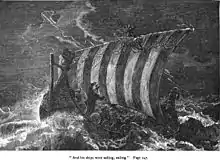The Saga of King Olaf
"The Saga of King Olaf" is a poetic sequence by American poet Henry Wadsworth Longfellow, published in 1863 as part of his book Tales of a Wayside Inn.
Overview

"The Saga of King Olaf" is written in twenty-two parts and follows the adventures of King Olaf of Norway, spurred to avenge his slain father and reclaim his kingdom by the Norse god Thor. It is the longest section of Longfellow's 1863 book Tales of a Wayside Inn, where it is presented as "The Musician's Tale". The Musician, in turn, is Longfellow's tribute to Norwegian violinist Ole Bull.[1]
It is also the oldest part of the book; Longfellow began writing it as early as 1856.[2] Longfellow scholar Christoph Irmscher notes it as "one of Longfellow's most accomplished tales".[1] The diversity of meters in the 22-part sequence also displays Longfellow's virtuosity as a poet.[2] The content of the poems draws heavily from the Heimskringla and ultimately implies little difference between the symbols of Thor's hammer and Christ's cross.[1]
Longfellow's friend and fellow writer Nathaniel Hawthorne was particularly pleased by "The Saga of King Olaf". He wrote to him particularly of the segment of "The Building of the Long Serpent": "By some inscrutable magic you contrive to suggest a parallel picture of a modern frigate."[3]
The work was the favorite poem of American President Theodore Roosevelt.[4] He compared the inspirational nature of the poem to "The Battle Hymn of the Republic" by Julia Ward Howe. As he wrote to literary critic Martha Baker Dunn, "if a boy or girl likes [the Saga] well enough to learn most of it by heart and feel the spirit of it, just as they ought to like Julia Ward Howe's battle hymn, they will always have in them something to which an appeal for brave action can be made."[5]
References
- Irmscher, Christoph. Longfellow Redux. Urbana: University of Illinois, 2006: 191. ISBN 978-0-252-03063-5.
- Calhoun, Charles C. Longfellow: A Rediscovered Life. Boston: Beacon Press, 2004: 233. ISBN 0-8070-7026-2.
- Hansen, Harry. Longfellow's New England. New York: Hastings House, 1972: 135. ISBN 0-8038-4279-1
- Morris, Edmund (2001). The Rise of Theodore Roosevelt. The Modern Library. pp. 1, 16. ISBN 0-375-75678-7.
- Holmes, James R. Theodore Roosevelt and World Order: Police Power in International Relations. Washington, DC: Potomac Books, Inc.: 11. ISBN 1-57488-883-8